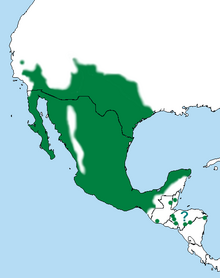The ladder-backed woodpecker (Dryobates scalaris) is a North American woodpecker.
| Ladder-backed woodpecker | |
|---|---|

| |
| Adult male outside cavity | |
| Scientific classification | |
| Domain: | Eukaryota |
| Kingdom: | Animalia |
| Phylum: | Chordata |
| Class: | Aves |
| Order: | Piciformes |
| Family: | Picidae |
| Genus: | Dryobates |
| Species: | D. scalaris
|
| Binomial name | |
| Dryobates scalaris (Wagler, 1829)
| |

| |
| Synonyms | |
|
Dendrocopos scalaris | |
Description
editThe ladder-backed woodpecker is a small woodpecker about 16.5 to 19 cm (6½ to 7½ inches) in length. It is primarily colored black and white, with a barred pattern on its back and wings resembling the rungs of a ladder. Its rump is speckled with black, as are its cream-colored underparts on the breast and flanks. Southern populations have duskier buff breasts and distinctly smaller bills. Adult males have a red crown patch that is smaller in immatures and lacking in adult females. The ladder-backed woodpecker is very similar in appearance to Nuttall's woodpecker, but has much less black on its head and upper back, and the range of the two species only intersects a minimal amount in southern California and northern Baja California. Hybrids are known.
Ladder-backed woodpeckers nest in cavities excavated from tree trunks, or in more arid environments a large cactus will do. The female lays between 2 and 7 eggs, which are plain white. The eggs are incubated by both sexes, but the nesting period and other details are unknown.
Like most other woodpeckers the ladder-backed woodpecker bores into tree-trunks with its chisel-like bill to hunt for insects and their larva, but it also feeds on fruit produced by cacti.
-
Juvenile male showing ladder back
Range and habitat
editThe ladder-backed woodpecker is fairly common in dry brushy areas and thickets and has a rather large range. The species can be found year-round over the southwestern United States (north to extreme southern Nevada and extreme southeastern Colorado), most of Mexico, and locally in Central America as far south as Nicaragua.
References
edit- ^ BirdLife International (2017). "Dryobates scalaris". The IUCN Red List of Threatened Species. 2017. IUCN: e.T22681152A118587827. doi:10.2305/IUCN.UK.2017-3.RLTS.T22681152A118587827.en. Retrieved 14 January 2018.
- Howell, Steve N. G.; Sophie Webb (1995). A Guide to the Birds of Mexico and Northern Central America. Oxford University Press. ISBN 0-19-854012-4.
External links
edit- Ladder-backed woodpecker, a bibliographic resource
